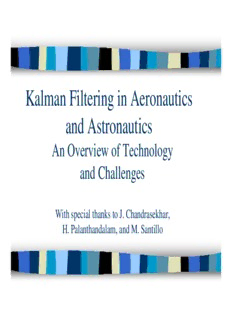
Kalman Filtering in Aeronautics and Astronautics PDF
Preview Kalman Filtering in Aeronautics and Astronautics
Kalman Filtering in Aeronautics and Astronautics An Overview of Technology and Challenges With special thanks to J. Chandrasekhar, H. Palanthandalam, and M. Santillo What is a Kalman Filter ? Merging models with data to obtain estimates of (cid:132) states – Data assimilation Stochastically optimal observer (cid:132) Model-based filter (cid:132) Development of the Kalman Filter Seminal Paper (cid:132) – R. E. Kalman, “A New Approach to Filtering and Prediction Problems,” Journal of Basic Engineering, Vol. 85D, pp. 35—45, 1960. Born 1930, Budapest, Hungary R. Kalman, J. Guid. Contr. Dynamics, 2003: (cid:132) – “the discovery of the Kalman filter came about through a single, gigantic, persistent mathematical exercise.” Key points: (cid:132) 1. “I simply defined a stochastic signal source consisting of a linear system and discrete white noise” 2. “I … establish[ed] for myself first the obvious relations and then the precise equivalence between transfer functions and linear vector differential equations.” 3. “No one imagined that the end result would be that simple.” • Recursive filter Kalman and Bucy, 1961: Continuous-time case (cid:132) Kalman Filtering Applications Aerospace Applications (cid:132) Guidance Tracking – Patriot missile, GPS, spacecraft Other Applications Ozone (cid:132) concentration data – Biological systems (measurements) • Drug concentrations – Stock trading Global field – Terrestrial weather after data assimilation – Space weather Data Assimilation noise disturbance output known input Real System unmeasured state performance Kalman Filter - filter measurement state Simulated Model filter - output filter error Output Injection Linear Stochastic System Time-varying linear system (cid:132) State variable Unknown Stochastic Measurement Known Stochastic Unmodeled driver Unknown Stochastic Sensor noise Unknown Stochastic Modeled driver Known Deterministic Unmodeled driver Unknown Deterministic The dimension of the state can be time varying (cid:132) – is not necessarily square !! Data Assimilation Filtering (cid:132) – Use measurements to determine the optimal estimate of Rigid body (cid:132) Position and velocity estimates Position and velocity estimates using position measurements using velocity measurements Position is not observable through velocity Filtering – Mass-Spring-Damper (MKC) system Estimates of position and velocity using velocity measurements Position is observable Estimates of position through velocity improve due to observability Optimal Estimator = estimate of (cid:132) Cost function: (cid:132) – – is the expected value operator Obtain optimal estimate of that minimizes (cid:132) . using measurements The optimal minimum variance estimate of is (cid:132) – Optimal for arbitrary dynamics and statistics Optimal Estimator Assumptions (cid:132) – Deterministic drivers are known ( ) – and are zero mean white Gaussian processes with covariances and , respectively – Initial state is Gaussian with known mean and known variance – and are uncorrelated (for convenience) Guarantees (cid:132) – Innovation – = Estimated measurement – are mutually independent (white) – and are jointly Gaussian
Description: